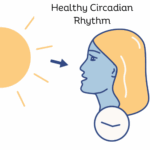This post explains why your circadian rhythm is so important for your bodily functions, especially when you have a chronic condition like MCAS. I recently posted about maximizing the benefits of circadian light signaling and circadian hygiene. This post is the third in the series and expands on why that is so important.
During my solo backpacking trip last summer, I always felt so much better when I was away from artificial light and soaking in the rays of the sun. I didn’t know why that was until this spring when I took a deeper dive into studying the connection between light and my circadian rhythm.
As an Amazon Associate, I earn from qualifying purchases.
Table of Contents
What is MCAS?
Mast Cell Activation Syndrome (MCAS) is a chronic condition that affects all organ systems. It can cause severe, disabling symptoms every day, including potentially fatal anaphylaxis. MCAS often occurs with other chronic conditions like Ehlers-Danlos Syndrome (EDS) and Postural Orthostatic Tachycardia Syndrome (POTS). Managing MCAS is challenging because many healthcare providers are unaware of it, and diagnostic tests can be unreliable. Treatments involve using antihistamines, mast cell stabilizers, and avoiding triggers. Check out this post on how to manage MCAS.
Why is your circadian rhythm so important for health?
“Circadian” refers to the length of a day, and “rhythm” signifies a pattern. All living creatures, including humans, have a natural 24-hour rhythm that we have identified to optimize our bodily functions.
Your body can optimize certain functions based on the time of day while downplaying others. This makes sense because if we tried to run all of the body’s programs continuously, it would be energetically wasteful and impractical. It wouldn’t promote an efficient system.
Humans are beautifully complex and optimized beings. We have evolved to engage in specific activities at crucial times throughout the day and night. Our bodies perform different functions during the day compared to at night. For the body to coordinate these activities effectively, it needs to be aware of when it is daytime and when it is nighttime.
Your body’s ability to recognize your circadian rhythm is negatively impacted by constant exposure to artificial light at any hour, day, or night. Your brain struggles to determine the actual time. Therefore, the first step in understanding our circadian rhythm is to acknowledge the importance of key light signals during the day and essential darkness signals at night.
Hormones
One key example of a bodily process tied to your circadian rhythm is the release of cortisol, a hormone that energizes us and is elevated in the morning.
Cortisol is meant to rise sharply in the morning, which is crucial for waking us up and providing us with energy for the day. This morning surge of cortisol also helps balance various hormonal pathways. Without this regular increase in cortisol, the brain and body may not recognize that morning has arrived.
Instead, you may experience either a flatlined cortisol level, or you may have irregular cortisol spikes, early in the morning, or later in the afternoon and evening. These fluctuations are chaotic and do not align with the body’s natural signals for the start of the day.
When your body receives the appropriate increase in cortisol in the morning, it understands that it needs to begin optimizing digestion because this increases your chances of finding, hunting, and gathering food. It also improves your muscular activity and balances hormones that can make you stronger, such as a surge in testosterone around nine or ten o’clock in the morning. Additionally, it helps to enhance libido and fertility for similar reasons.
Blue light
These hormones are essential for maintaining an optimum balance necessary for your body to be fertile, and this balance relies heavily on light signaling. Your body’s accurate timing is set by seeing the blue wavelength range of light. Blue light from the sun changes predictably throughout the day. It varies from dawn to solar noon, when the sun is at its highest point in the sky, and continues to change until dusk and after sunset.
As the sun rises above the horizon at sunrise, the intensity of blue light emitted by the sun begins to increase. You have receptors in the back of your eyes that are sensitive to these blue wavelengths called melanopsin receptors. These receptors are connected by a pathway called the retinohypothalamic tract. Essentially, your melanopsin receptors allow you to capture blue wavelengths of light.
The amount of blue light you receive tells your brain what time of day it is. Located near your hypothalamus is a part of your brain called the suprachiasmatic nucleus, which acts as the master timekeeper for your brain and the entire body.
The system receives input based on the time of day, which is determined by the amount of blue light detected by the receptors in your eyes. It begins to oscillate or beat, much like a metronome. Before sunrise, when no blue light is present, the rhythm is steady as it senses darkness.
At sunrise, as the sun breaks the horizon, your sensors begin to detect small amounts of blue light. As a result, the metronome in your brain—your internal clock, or oscillator—starts to speed up a little.
As the sun rises higher in the sky, it emits more blue light, and your sensors detect an increasing range of blue wavelengths. This information is communicated to the internal clock in your brain, which reacts by beating faster.
When the sun is at its highest point in the sky, your internal clock beats at its fastest rate of the day. Later in the day, as the amount of blue light diminishes predictably when the sun begins to dip below the horizon, the beating slows down again.
The vibrations produced by the beating of your internal clock are felt by every cell in your body, allowing them to synchronize with the time of day. This is how your hypothalamic-pituitary-adrenal axis knows it’s morning and triggers the release of cortisol.
It’s also how your hypothalamic-pituitary-pancreatic axis knows when it’s time to prime the body for digestion. A hundred thousand tasks are occurring within every cell of your body every second, all of which depend on precise timing.
The problem with modern indoor lighting
In modern living, you can essentially wake up at any time you choose, regardless of when the sun rises. The first thing many of us do in the morning is look at our cell phones, which emit a significant amount of blue light. As a result, your brain’s internal rhythm shifts abruptly from the calm pace of sleep to a more alert state, and the beating of your internal clock jolts from zero to beating rapidly.
Then, between the middle of late morning and the early afternoon, the day feels quite chaotic due to that artificial spike in cortisol your body experienced. The timing of your internal clock gets off, and you may experience a significant surge in cortisol at times, while at other times, you might not have enough. This in turn affects your digestive pathways.
Your muscular function, thyroid activation, and cognition can all become quite chaotic when light signaling is off, causing your internal clock to be off. When you return to work under artificial light and in front of screens, your internal metronome starts to go haywire at odd times.
At the end of the work day, you leave the office and step outside when the sun is setting, your internal clock slows down slightly. However, when you get home, if you decide to watch TV, your energy picks back up again with exposure to the blue light from screens and artificial indoor lighting.
The circadian chaos of late afternoon repeats itself because, instead of a smooth rise and fall in cortisol levels signaled by increasing and decreasing blue light of the sun, there are random bursts of intense activity that your brain struggles to interpret. This chaotic signaling overwhelms the cells in your body as well.
How a disrupted circadian rhythm isn’t healthy
A disrupted circadian rhythm is associated with several chronic diseases, including obesity, diabetes, non-alcoholic fatty liver disease, various types of chronic pain and inflammation, anxiety, depression, irritable bowel syndrome, gut health issues, autoimmune diseases, and even cancer.
It is crucial to understand that this is fundamental for achieving optimal health. So, how can you align our circadian rhythm? The first step is to block artificial blue light from reaching your eyes before sunrise and after sunset.
To protect your eyes, you can wear orange-tinted blue light blockers. The orange tint is effective because it blocks blue light from entering your eyes. Even when you look at your cell phone screen or have a light bulb on in the morning or evening, these orange lenses help shield your eyes from harmful blue light.
After sunset, make sure to wear red or orange-tinted blue light-blocking glasses again to help your brain understand that even though you may be looking at the TV or your cell phone screen, it’s still evening. Bon Charge offers lenses such as yellow and red-tone blue-blocking glasses that block blue light and help you maintain your proper circadian rhythm. Use code BETSYL for 15% off from Bon Charge.
The absence of blue light for the hours before bedtime signals that it is nighttime, prompting your pineal gland to produce large amounts of melatonin. This is an essential signal that it is time for rest.
Getting natural light
You may not be producing melatonin if you aren’t blocking artificial blue light at night. It’s crucial to take steps to reduce exposure to artificial light in the evening. Additionally, there are specific times in the morning when it’s beneficial to spend time outdoors.
Sunrise is a great opportunity to step outside for a few minutes. Take some time to gaze at the sky and let your eyes absorb the light, capturing all the wavelengths. Your eyes, acting as receptors and sensors, can detect the amount of blue light present, no matter if it’s cloudy, rainy, foggy, or perfectly sunny. This experience, in turn, signals the start of your day to your inner clock.
During the day, step outside without glasses, contacts, or, especially, sunglasses. This allows your brain to recognize that the day has begun, activating your natural internal clock. To stay in sync with natural light, it’s important to take frequent breaks outside in natural light. Try to take five breaks throughout the day to reconnect with that natural light.
The breaks don’t need to be long, but the more you can enhance exposure to morning light, the better. Consider incorporating two or three key breaks to go outside and reconnect with natural light. This helps the brain recognize the day’s rhythm. As a result, other cues can align with this rhythm even when you are indoors.
While driving, you might roll down the windows for fresh air and take advantage of natural light. Consider taking a slightly longer walk from your parking spot to your workplace or from work to your car at the end of the day. If you find a park bench nearby, take a few minutes to sit outside and allow the natural light to help reset your internal clock. If you can take some of your work outside, that’s even better.
Resynching is more effective in the springtime
One of the great things about spring is that it supports our circadian rhythms. During this season, we transition away from the extreme imbalance of long nights and short days. The amount of light and darkness becomes more balanced. This means that going outside at sunrise provides an excellent opportunity to align your rhythms with the natural cycle, making it an important time for us to connect with the changing environment.
There may be times during the summer when the sunrise occurs too early for you to get outside and enjoy it, and that’s perfectly fine. It’s more important to focus on aligning with your circadian rhythm in the springtime by taking advantage of the sunrise in the morning. Additionally, try to limit exposure to artificial light before sunrise and after sunset. This practice can significantly contribute to maintaining a strong circadian rhythm and promoting overall circadian health.
To determine the time of sunrise in your location, there are several methods you can use. One popular option is to check weather apps that provide sunrise information. I recommend the Circadian Life app, which you can download to find out sunrise times.
You can program your location into this app, and it will inform you of sunrise times. It also provides information on when to produce Vitamin D, when UVA light appears, and when sunset occurs. It’s a fantastic tool to stay updated on the light conditions in your environment and to know the best times to go outside for essential exposure to natural light.
The changes I’m advocating only require a few small adjustments in your routines. It’s about making a lifestyle shift—a behavioral change in recognizing the importance of light signaling to the eyes. Understanding this can greatly support your health or, conversely, lead your body toward chaos and disease.
The bucket theory
The bucket theory simplifies understanding symptom reactions with MCAS. Imagine your body as an empty bucket you don’t want to overflow. Reactions to various stimuli fill the histamine bucket at different rates, forming the total histamine level (how full your bucket is). More histamine means more symptoms. By managing triggers, reducing exposures, and taking medications and supplements, you can control your bucket’s level.
Know your typical symptom progression
Knowing your symptom progression in a flare is the key to developing your rescue plan. This post discusses how to recognize your symptom progression to be prepared to address those symptoms.
Get my free ebook, symptom log, and meal plan!
Want a tool to easily keep track of your symptoms? Sign up for my newsletter and you will receive my free 50-page ebook of lower-histamine, grain-free, sugar-free recipes, my free symptom log, and a free two-week meal plan!
Check out these circadian health tools!
I’m an affiliate with Bon Charge, a company that makes tools for circadian health, and you can receive 15% off your order with my coupon code BETSYL.
Bon Charge offers tools such as yellow and red-tone blue-blocking glasses, red light therapy devices, PEMF mats, infrared saunas, and EMF blocking products.
Sign up for the SSP!
If you are dealing with chronic illness, concussions, or trauma, the Safe and Sound Protocol (SSP) is a listening therapy based on Polyvagal Theory that helps heal nervous system dysregulation. Many people with MCAS and other chronic conditions have nervous system dysregulation stemming from infections, toxic exposures, concussions, and trauma. The SSP is an easy-to-use app where you listen to specially filtered music for 30 minutes each day for a 5-hour cycle. Studies show the SSP has a profound effect on mental health and chronic conditions
You can sign up for the SSP here!
Heal your mind!
While the SSP is a bottom-up or somatic therapy for healing the nervous system, the Sacred Self-Healing Method I offer is a top-down nervous system healing modality that focuses on cognition, attention, perception, and emotion, using the mind’s higher functions. The SSP and the Sacred Self-Healing Method complement each other and together produce lasting results.
I provide one-on-one in-person and remote chronic illness and caregiver coaching and Sacred Self-Healing Sessions based on the Sacred Self-Healing Method, a proven novel co-creative healing modality detailed in my Books.
Click here for more information.
Order my books!
Rocks and Roots chronicles my journey solo backpacking the Superior Hiking Trail and overcoming nervous system dysregulation, gut dysbiosis, and Mast Cell Activation Syndrome symptoms to hike 328 miles successfully.
The Sacred Self-Healing Method ebook is available here and in most ebook retailers!
The Sacred Self-Healing Workbook is available for purchase here!
Betsy’s first book, Sacred Self-Healing: Finding Peace Through Forgiveness, is available here
Companion Recordings
The companion audio recordings of chants, guided meditations, and sound healing demonstrations that accompany Sacred Self-Healing: Finding Peace Through Forgiveness are available to download for free here
What do you think?
I’d love to have your reply below!
Disclaimer
The preceding material does not constitute medical advice. This information is for information purposes only and is not intended to be a substitute for professional medical advice, diagnosis, cure or treatment. Always seek advice from your medical doctor.




